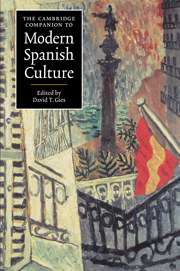Book contents
- Frontmatter
- Modern Spanish culture
- I Culture
- II Culture and history
- III Culture and prose
- IV Culture and poetry
- V Culture and theater
- VI Culture and the arts
- 17 Painting and sculpture in modern Spain
- 18 Culture and cinema to 1975
- 19 Culture and cinema, 1975-1996
- 20 A century of Spanish architecture
- 21 Spanish music and cultural identity
- 22 To live is to dance
- VII Media
- Index
- Series List
22 - To live is to dance
from VI - Culture and the arts
Published online by Cambridge University Press: 28 May 2006
- Frontmatter
- Modern Spanish culture
- I Culture
- II Culture and history
- III Culture and prose
- IV Culture and poetry
- V Culture and theater
- VI Culture and the arts
- 17 Painting and sculpture in modern Spain
- 18 Culture and cinema to 1975
- 19 Culture and cinema, 1975-1996
- 20 A century of Spanish architecture
- 21 Spanish music and cultural identity
- 22 To live is to dance
- VII Media
- Index
- Series List
Summary
Spain is a country of dancers. Residents of small towns and villages perform ancestral folk dances during the local festivities. Crowds gather on Sundays before the cathedral of Barcelona to perform Catalonia's emblematic sardana and young people fill the discotheques every weekend. When Felipe González, a native of Seville, was elected prime minister in 1982 the Andalusian folk dance sevillanas enjoyed a popular revival that still endures.
Blessed with one of the most diverse dance cultures in the world, Spain is invariably identified with Andalusian flamenco. Today's Spain, with its well-defined autonomous regions, presents a much wider spectrum of dance than that which was promoted by the Franco regime. A new generation of artists is leading flamenco into the twenty-first century, while Spanish modern and ballet dancers and choreographers are well equipped to hold their own anywhere in the world.
Born as a melding of Spain's gypsy, Moorish and Jewish heritages, flamenco furnishes an outlet for individual temperament. Centered around rhythm, or compás, its musical structures provide opportunities for improvisation and communication between singers, guitarists, and dancers. The contrast between driving staccato heelwork, pressed downwards towards the earth, and the majestic lifting of the upper body illustrates the dichotomy of the flamenco essence, as eloquent an expression of intense sorrow as it is of uncomplicated, sheer love of life and joy.
- Type
- Chapter
- Information
- The Cambridge Companion to Modern Spanish Culture , pp. 298 - 306Publisher: Cambridge University PressPrint publication year: 1999



